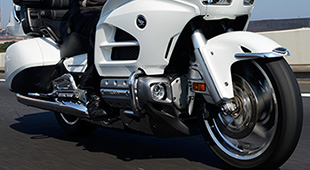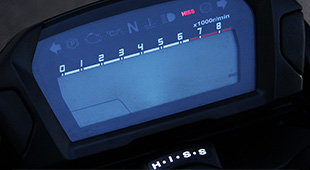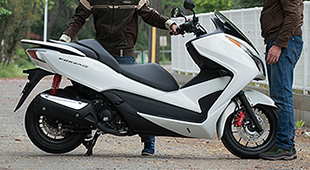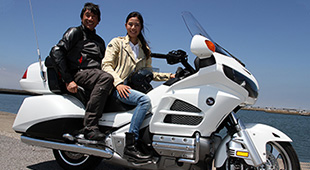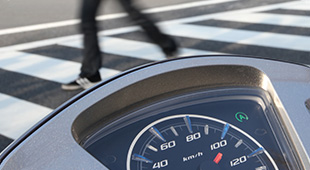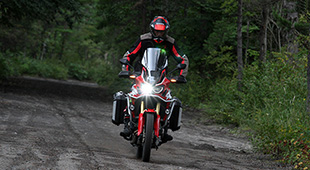Tech Views — Vol. 4 H.I.S.S.
Impressions
Though its effects are outstanding, this theft deterrent changes nothing from the usual.

"Gangs of motorcycle thieves are running rampant!" - Scary news stories like this can be seen and heard almost anywhere in the world these days. As a rider, I get especially disgusted with a situation in which so many bike thefts are taking place. These ominous circumstances have become an endless source of anxiety, and I get angry whenever I hear the news. It's hard to accept that people's beloved bikes are being so easily stolen.
So, it's only natural that we take defensive action. Responding to this crisis, many anti-theft devices can be found in shops that carry motorcycle gear. From U-locks, to cable and chain locks, to disc brake rotor locks that stop the wheels from turning, to motion detector alarms and more. The more robust the device is, the greater the gains in perceived protection, but it's always such a bother to have to carry that stuff around wherever you go. And besides, these security devices aren't cheap.
Then, what do the bike thieves think of these anti-theft items?
Whenever a new anti-theft device appears on the market, thieves scramble to prepare the tools they'll need to break the new device and continue their thefts, creating a vicious circle. However, thieves also prefer bikes equipped with no anti-theft devices, or having easily breakable ones, over those equipped with troublesome and time-consuming devices. In other words, it's best that thieves think that "this bike is going to be difficult to steal," which is another effective means of repelling theft.
Every manufacturer takes positive measures to protect against theft.
In Honda's case, these include:
- Key cylinder shutters that rotate to cover-up the ignition key hole with a metal plate, this preventing picking and tampering with the key cylinder. Honda is also making efforts to integrate key switches, so that the main key can either switch on the ignition or open the seat lock depending on which direction it's turned. Efforts have also been made to reinforce the construction of the key cylinders and handle locks themselves.
- Anti-theft systems with circuitry that prevents the engine from being started, even if hot-wired in an attempt to bypass the security system.
- Locking centerstands that prevent bikes from being stolen by being pushed away from where they're parked.
- Immobilizers that use the main ECU's electronics to control the starting of the engine.
Honda's immobilizer is called H.I.S.S., which stands for Honda Ignition Security System.
H.I.S.S. offers the following features:
A microchip embedded in the original key is programmed with a coded password that can't be picked up by any antenna-like devices that could read the code and subsequently communicate it to the ECU when another key is inserted into the ignition. The ECU checks the programmed code number and only allows the engine to start when the code numbers match. For example, even if a duplicate key of exactly the same shape as the original key is used, the engine cannot be started unless the built-in microchip code matches. No match, no start.
In other words, arrangements have been made to prevent the engine from being started without the motorcycle's original key. The fact that the engine cannot be started means that thieves must think of some way to physically carry the bike away, since they can't ride it, and the black market resale value of a motorcycle that can't be started would be greatly diminished.
A more significant feature of H.I.S.S. is that it uses a contact communications method, like the IC cards of major public transport systems, to communicate the key's coded password to the ECU. Generally, the vast majority of immobilizers use contact-free radio signals to communicate between keys or key fobs and vehicles. These radio signal types literally initiate communications between the IC chips built inside the key and the bike's security system.
And in spite of key-to-vehicle communications taking place over very short distances, the possibility that communication failures could occur due to the influence of radio signals saturating urban areas, or thieves abusing communication signals to get engines started, can't be denied.
In contrast to these types of push-button security systems, H.I.S.S. employs contact-type communi- cations. Inserting the original key into the ignition instantly starts chip communications within the key cylinder. It is impervious to both radio interference and signal interception, which is to say its operation is resistant to outside influence.
In spite of this, the real convenience of H.I.S.S. is that it starts operating the instant the key is removed from the vehicle's ignition. In other words, protection against theft requires no special action, as there's no switch or button to forget to turn on.
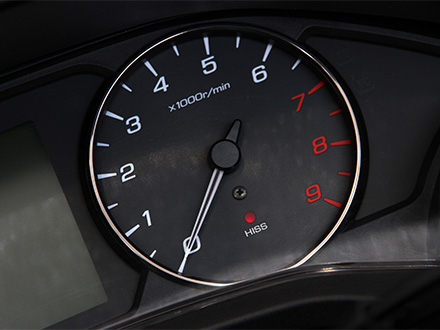
And for the first 24 hours that the bike is parked, a red LED lamp can be seen in the meter display, signaling its operation to passersby with a flash every 2 seconds to indicate that its anti-theft device is in operation.
Even though basically user-friendly, the radio signal communications employed by many immobilizers can still panic a user. When on the road, system errors or inability to start the engine can arise owing to communication conditions between the key and the bike's security system.
A similar situation could occur if the built-in battery used to power communications is completely discharged.
And in the case of these sorts of radio signal type immobilizers, it's been said that thieves are using new devices to intercept the transmitted radio signals, then retransmitting the copied signal, which is recognized as if it were coming from the correct key.
In this respect, Honda's system has the advantage as well.
In my own case, while on a magazine shoot in a remote locale, the immobilizer on the bike I'd borrowed failed, and I couldn't get the engine started. I couldn't just leave the bike there and go home, and I clearly recall having a lot of trouble dealing with the situation. Stuck out on the road, I had no idea what was causing the system error, and contacting the maker's press office got no results. So in the end, I had to start the trip all over again.
A situation like this could have major implications if it occurred while out on a weekend ride. First, I might not be able to leave home. Or I could be left stranded out on the road, and be forced to call a tow truck to carry the bike to a dealer, since it can't be repaired at my touring destination, thus forcing me to completely change my travel plans.
Despite this, I reluctantly accept this theft deterrent. However, once you've had this sort of experience, it's not pleasant to find yourself asking "Am I going to be alright this time?," and praying for a safe trip every time you step out the door.
In fact, I used H.I.S.S. myself when riding a CBR954RR. Or more correctly, it was equipped that way. I could ride this H.I.S.S.-equipped machine the same way I'd ridden other bikes for over 30 years, but it offered highly effective-and totally automatic-electronic anti-theft protection.
To sum up, with H.I.S.S. the engine is impossible to be start without using the bike's original key. And even if thieves carry the bike away in a truck, both the ECU and the key cylinder must be replaced before it can be ridden or resold. And since replacement is costly, the theft doesn't pay. Also, even if the thief goes to a dealer pretending to be the bike owner and claims he lost his key, he can't replace the ECU and key until his ownership and identity are confirmed, so getting over these hurdles is going to be a lot of trouble for any thief. In other words, motorcycles equipped with H.I.S.S. make lousy targets for most thieves.
What's more, that red H.I.S.S. LED continues to flash around the clock, whispering every two seconds, "You're looking for trouble if you try to steal this. Don't even think about stealing this bike." Fortunately, I never experienced any theft or acts of vandalism while riding the CBR954RR. And even if I'm not particularly aware of it, thieves will quickly recognize what a headache H.I.S.S. is. Or rather, the most effective way to deter theft is to let thieves clearly see that a bike is equipped with H.I.S.S. Then they'll decide to look elsewhere for targets rather than taking aim at a bike equipped with H.I.S.S. This is surely an excellent anti-theft side-effect of having H.I.S.S.
Using this motorcycle the same way as ever, nothing special has to be done to reap the highly effective rewards of H.I.S.S. as it automatically protects against theft. I couldn't be more grateful for this technology and this device. Although few riders have a chance to test out its performance themselves, it's almost the same as hiring a good, but invisible, security guard. Definitely a reassuring technology. However, thieves are sure to be looking for new ways to steal bikes, so we shouldn't let down our guard or slacken our efforts to protect our beloved bikes by using a second and third anti-theft device besides H.I.S.S.
[H.I.S.S. Equipped Models]
300cc: SH300, NSS300
400cc: CB400, FJS400D/A, VT400S, VT400C
500cc: CB500F, CBR500R
600cc: CB600F, CBR600F, CBR600RR, FJS600A, CBF600S/N, CBR650F
700cc: NC700X, NC700V, NSA700, XL700V, CTX700N, CTX700NA CTX700ND, CTX700A, CTX700D750cc:NC750D, NC750SD, NC750SA, NC750PA, NC750S, NC750X, NC750, VT750S, VT750C, VT750C2
800cc: VFR800, VFR800X, VFR800F
1000cc: CB1000R, CBF1000, CBF1000F, CBR1000RR, XL1000V
1100cc: CB1100
1200cc: VFR1200F, VFR1200X
1300cc: CB1300, ST1300A, VT1300C, CTX1300
1800cc: GL1800, GL1800B, GL1800C
*Production models as of Mar. 4, 2014
*Models may vary depending on regional specifications.
*The H.I.S.S.-equipped models listed above are included for reference purposes only. H.I.S.S. and model availability may differ depending on region and country. Please contact you nearest Honda dealership for more information regarding H.I.S.S.-equipped models in your area.
- Top
- Impressions
- Q&A
- User Reviews

